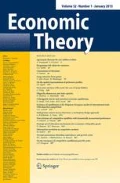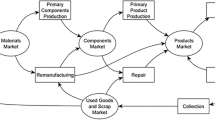Abstract
How far can we go in weakening the assumptions of the general equilibrium model? Existence of equilibrium, structural stability and finiteness of equilibria of regular economies, genericity of regular economies and an index formula for the equilibria of regular economies have been known not to require transitivity and completeness of consumers’ preferences. We show in this paper that if consumers’ non-ordered preferences satisfy a mild version of convexity already considered in the literature, then the following properties are also satisfied: (1) the smooth manifold structure and the diffeomorphism of the equilibrium manifold with a Euclidean space; (2) the diffeomorphism of the set of no-trade equilibria with a Euclidean space; (3) the openness and genericity of the set of regular equilibria as a subset of the equilibrium manifold; (4) for small trade vectors, the uniqueness, regularity and stability of equilibrium for two version of tatonnement; (5) the pathconnectedness of the sets of stable equilibria.
Similar content being viewed by others
References
Al-Najjar N.: Non-transitive smooth preferences. J Econ Theory 60, 14–41 (1993)
Antonelli, G.: Sulla teoria matematica della economia politica, 1886, chap. 16, pp. 333–360. In: Chipman et al. (eds.): Preferences, Utility, and Demand. New York: Harcourt Brace Jovanovich (1971)
Arrow K.J., Hurwicz L.: On the stability of the competitive equilibrium I. Econometrica 26, 522–552 (1958)
Arrow K.J., McManus M.: A note on dynamic stability. Econometrica 26, 448–454 (1958)
Balasko Y.: The graph of the Walras correspondence. Econometrica 43, 907–912 (1975a)
Balasko Y.: Some results on uniqueness and on stability of equilibrium in general equilibrium theory. J Math Econ 2, 95–118 (1975b)
Balasko Y.: Connectedness of the set of stable equilibria. SIAM J Appl Math 35, 722–728 (1978a)
Balasko Y.: Economic equilibrium and catastrophe theory: an introduction. Econometrica 46, 557–569 (1978b)
Balasko Y.: Foundations of the Theory of General Equilibrium. Academic Press, Boston (1988)
Balasko Y.: The set of regular equilibria. J Econ Theory 58, 1–9 (1992)
Balasko Y.: Economies with price-dependent preferences. J Econ Theory 109, 333–359 (2003)
Balasko Y.: Out-of-equilibrium price dynamics. Econ Theory 33, 413–435 (2007)
Bonnisseau J.M.: Regular economies with non-ordered preferences. J Math Econ 39, 153–174 (2003)
Borglin A., Keiding H.: Existence of equilibrium actions and of equilibrium: a note on the “new” existence theorem. J Math Econ 3, 313–316 (1976)
Chipman, J., Hurwicz, L., Richter, M., Sonnenschein, H. (eds.): Preferences, Utility, and Demand. New York: Harcourt Brace Jovanovich (1971)
Debreu G.: Economies with a finite set of equilibria. Econometrica 38, 387–392 (1970)
Debreu G.: Smooth preferences. Econometrica 40, 603–615 (1972)
Dierker E.: Two remarks on the number of equilibria of an economy. Econometrica 40, 951–953 (1972)
Gale D., Mas-Colell A.: An equilibrium existence theorem for a general model without ordered preferences. J Math Econ 2, 9–15 (1975)
Katzner D. et al.: Demand and exchange in the absence of integrability conditions. In: Chipman, et al. (eds) Preferences, Utility, and Demand, pp. 254–270. Harcourt Brace Jovanovich, New York (1971)
Kihlstrom T., Mas-Colell A., Sonnenschein H.: The demand theory of the weak axiom of revealed preferences. Econometrica 44, 971–978 (1976)
Loewenstein G., Drazen P.: Anomalies in intertemporal choice: evidence and an interpretation. Q J Econ 107, 573–597 (1992)
Loomes G., Taylor C.: Non-transitive preferences over gains and losses. Econ J 102, 357–365 (1992)
Milnor J.: Topology from the Differentiable Viewpoint, 2nd edn. Princeton University Press, Princeton (1997)
Pareto V.: Manuel d’Economie Politique. Rouge, Lausanne (1909)
Philips M.: Must rational preferences be transitive?. Phil Q 39, 477–483 (1989)
Samuelson P.A.: Foundations of Economic Analysis. Harvard University Press, Cambridge (1947)
Schecter S.: On the structure of the equilibrium manifold. J Math Econ 6, 1–7 (1979)
Schmeidler D.: Competitive equilibria in markets with a continuum of traders and incomplete preferences. Econometrica 37, 578–585 (1969)
Shafer W.: The nontransitive consumer. Econometrica 42, 913–919 (1974)
Shafer W., Sonnenschein H.: Equilibrium in abstract economies without ordered preferences. J Math Econ 2, 345–348 (1975)
Smale S.: Global analysis and economics. III. Pareto optima and price equilibria. J Math Econ 1, 107–117 (1974)
Walras L.: Eléments d’Economie Politique Pure, 1st edn. Corbaz, Lausanne (1874)
Yannelis N.C., Prabhakar N.D.: Existence of maximal elements and equilibria in linear topological spaces. J Math Econ 12, 233–245 (1983)
Author information
Authors and Affiliations
Corresponding author
Additional information
We are grateful to an anonymous referee of this Journal for insightful comments.
Rights and permissions
About this article
Cite this article
Balasko, Y., Tvede, M. General equilibrium without utility functions: how far to go?. Econ Theory 45, 201–225 (2010). https://doi.org/10.1007/s00199-009-0496-3
Received:
Accepted:
Published:
Issue Date:
DOI: https://doi.org/10.1007/s00199-009-0496-3




